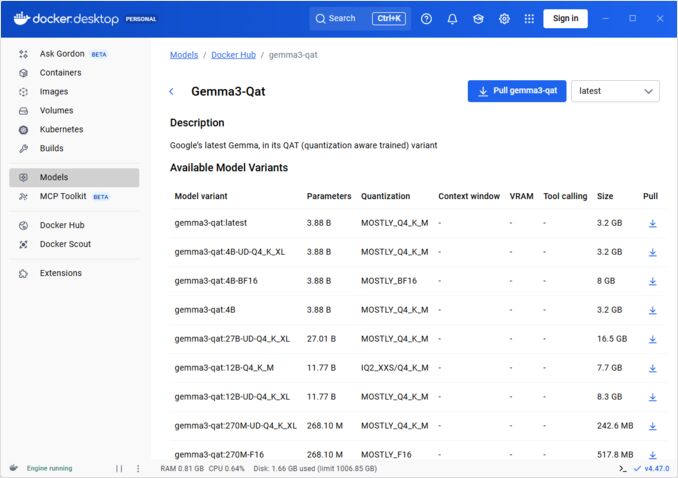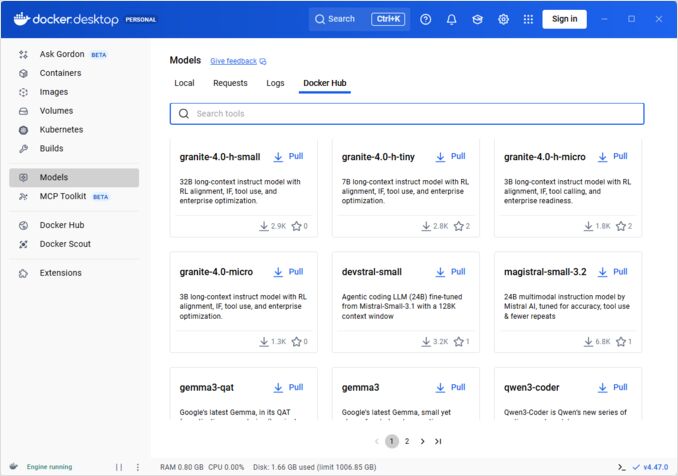Docker Model Runner 快速参考:命令与示例
Docker Model Runner 命令快速参考
Docker Model Runner (DMR) 是 Docker 官方用于本地运行 AI 模型的解决方案,于 2025 年 4 月推出。此快速参考提供了所有关键命令、配置和最佳实践的快速查阅。

安装
Docker Desktop
通过图形界面启用 Docker Model Runner:
- 打开 Docker Desktop
- 转到 设置 → AI 选项卡
- 点击 启用 Docker Model Runner
- 重启 Docker Desktop
/home/rg/prj/hugo-pers/content/post/2025/10/docker-model-runner-cheatsheet/docker-model-runner_w678.jpg

Docker Engine (Linux)
安装插件包:
# Ubuntu/Debian
sudo apt-get update
sudo apt-get install docker-model-plugin
# Fedora/RHEL
sudo dnf install docker-model-plugin
# Arch Linux
sudo pacman -S docker-model-plugin
验证安装:
docker model --help
Docker 的 NVIDIA RTX 支持
为了使 LLM 在 GPU 上运行而不是 CPU 上,安装 nvidia-container-toolkit:
distribution=$(. /etc/os-release;echo $ID$VERSION_ID)
curl -fsSL https://nvidia.github.io/libnvidia-container/gpgkey | sudo gpg --dearmor -o /usr/share/keyrings/nvidia-container-toolkit-keyring.gpg
curl -s -L https://nvidia.github.io/libnvidia-container/stable/deb/nvidia-container-toolkit.list | sed 's#deb https://#deb [signed-by=/usr/share/keyrings/nvidia-container-toolkit-keyring.gpg] https://#g' | sudo tee /etc/apt/sources.list.d/nvidia-container-toolkit.list
sudo apt-get update
sudo apt-get install -y nvidia-container-toolkit
sudo systemctl restart docker
然后你可以使用 --gpus all 运行容器:
docker run --rm --gpus all <image> <command>
检查容器是否能识别 GPU:
docker run --rm --gpus all nvidia/cuda:12.2.2-base-ubi8 nvidia-smi
为 Docker Model Runner 添加 NVIDIA 支持
Docker Model Runner 需要显式配置 GPU。与标准的 docker run 命令不同,docker model run 不支持 --gpus 或 -e 标志。相反,你需要:
- 配置 Docker 守护进程默认使用 NVIDIA 运行时
首先,检查 nvidia-container-runtime 的安装位置:
which nvidia-container-runtime
这通常会输出 /usr/bin/nvidia-container-runtime。在下面的配置中使用此路径。
创建或更新 /etc/docker/daemon.json:
sudo tee /etc/docker/daemon.json > /dev/null << 'EOF'
{
"default-runtime": "nvidia",
"runtimes": {
"nvidia": {
"path": "/usr/bin/nvidia-container-runtime",
"runtimeArgs": []
}
}
}
EOF
注意: 如果 which nvidia-container-runtime 返回不同的路径,请相应地更新 JSON 配置中的 "path" 值。
重启 Docker:
sudo systemctl restart docker
验证配置:
docker info | grep -i runtime
你应该在输出中看到 Default Runtime: nvidia。
- 使用 GPU 支持重新安装 Docker Model Runner
Docker Model Runner 必须使用显式的 GPU 支持进行安装/重新安装:
# 停止当前运行器
docker model stop-runner
# 使用 CUDA GPU 支持重新安装
docker model reinstall-runner --gpu cuda
这将拉取启用 CUDA 的版本 (docker/model-runner:latest-cuda) 而不是仅 CPU 版本。
- 验证 GPU 访问
检查 Docker Model Runner 容器是否可以访问 GPU:
docker exec docker-model-runner nvidia-smi
- 使用 GPU 测试模型
运行模型并检查日志以确认 GPU 使用情况:
docker model run ai/qwen3:14B-Q6_K "who are you?"
检查日志以确认 GPU 使用情况:
docker model logs | grep -i cuda
你应该看到类似以下的消息:
using device CUDA0 (NVIDIA GeForce RTX 4080)offloaded 41/41 layers to GPUCUDA0 model buffer size = 10946.13 MiB
注意: 如果你已经安装了没有 GPU 支持的 Docker Model Runner,你必须使用 --gpu cuda 标志重新安装。仅仅配置 Docker 守护进程是不够的 - 运行器容器本身需要是启用 CUDA 的版本。
可用的 GPU 后端:
cuda- NVIDIA CUDA(最常见)rocm- AMD ROCmmusa- Moore Threads MUSAcann- Huawei CANNauto- 自动检测(默认)none- 仅 CPU
核心命令
拉取模型
从 Docker Hub 拉取预打包模型:
# 基本拉取
docker model pull ai/llama2
# 拉取特定版本
docker model pull ai/llama2:7b-q4
# 从自定义注册表拉取
docker model pull myregistry.com/models/mistral:latest
# 列出命名空间中的可用模型
docker search ai/
运行模型
启动模型并自动提供 API 服务:
# 基本运行(交互式)
docker model run ai/llama2 "What is Docker?"
# 作为服务运行(后台)
docker model run -d
通过 CLI 运行模型时,我们目前没有太多选项:
docker model run --help
Usage: docker model run MODEL [PROMPT]
运行模型并使用提交的提示或聊天模式与模型进行交互
选项:
--color string 使用彩色输出(auto|yes|no)(默认 "auto")
--debug 启用调试日志
-d, --detach 在后台加载模型而不进行交互
--ignore-runtime-memory-check 如果模型的预估运行时内存超过系统资源,不要阻止拉取。
列出模型
查看已下载和正在运行的模型:
# 列出所有已下载的模型
docker model ls
# 列出正在运行的模型
docker model ps
# 列出详细信息
docker model ls --json
# 列出详细信息
docker model ls --openai
# 将返回哈希码
docker model ls -q
删除模型
从本地存储中删除模型:
# 删除特定模型
docker model rm ai/llama2
# 强制删除(即使正在运行)
docker model rm -f ai/llama2
# 删除未使用的模型
docker model prune
# 删除所有模型
docker model rm $(docker model ls -q)
配置模型上下文大小
我们不能使用 CLI 为特定请求指定上下文大小。
基本上,只能通过以下三种方式控制模型上下文大小:
-
自己打包模型,指定所需的硬编码上下文大小(有关此内容的更多信息,请参见下一节。)
-
使用 docker model runner 配置命令时,使用
--context-size参数,例如:
docker model configure --context-size=10000 ai/gemma3-qat:4B
然后你可以使用 curl 调用它,但不能使用 docker model run... - 该命令将忽略配置。
- 在
docker-compose.yaml文件中,但我们不能以这种方式使用 docker-model-runner 图像,因为它是传递给模型的硬编码上下文大小为 4096
...
models:
llm_model:
model: ai/gemma3-qat:4B
context_size: 10240
...
有关更多详细信息,请参阅专门的帖子: 在 DMR 中指定上下文大小
打包自定义模型
从 GGUF 创建 OCI 工件
打包自己的 GGUF 模型:
# 基本打包
docker model package --gguf /path/to/model.gguf myorg/mymodel:latest
# 带有元数据的打包
docker model package \
--gguf /path/to/model.gguf \
--label "description=Custom Llama model" \
--label "version=1.0" \
myorg/mymodel:v1.0
# 一次性打包并推送
docker model package --gguf /path/to/model.gguf --push myorg/mymodel:latest
# 带有自定义上下文大小的打包
docker model package \
--gguf /path/to/model.gguf \
--context 8192 \
myorg/mymodel:latest
发布模型
将模型推送到注册表:
# 登录到 Docker Hub
docker login
# 推送到 Docker Hub
docker model push myorg/mymodel:latest
# 推送到私有注册表
docker login myregistry.com
docker model push myregistry.com/models/mymodel:latest
# 标记并推送
docker model tag mymodel:latest myorg/mymodel:v1.0
docker model push myorg/mymodel:v1.0
API 使用
OpenAI 兼容端点
Docker Model Runner 自动暴露 OpenAI 兼容的 API:
# 启动模型并启用 API
docker model run -d -p 8080:8080 --name llm ai/llama2
# 聊天完成
curl http://localhost:8080/v1/chat/completions \
-H "Content-Type: application/json" \
-d '{
"model": "llama2",
"messages": [{"role": "user", "content": "Hello!"}]
}'
# 文本生成
curl http://localhost:8080/v1/completions \
-H "Content-Type: application/json" \
-d '{
"model": "llama2",
"prompt": "Once upon a time",
"max_tokens": 100
}'
# 流式响应
curl http://localhost:8080/v1/chat/completions \
-H "Content-Type: application/json" \
-d '{
"model": "llama2",
"messages": [{"role": "user", "content": "Tell me a story"}],
"stream": true
}'
# 通过 API 列出可用模型
curl http://localhost:8080/v1/models
# 模型信息
curl http://localhost:8080/v1/models/llama2
Docker Compose 配置
基本 Compose 文件
version: '3.8'
services:
llm:
image: docker-model-runner
model: ai/llama2:7b-q4
ports:
- "8080:8080"
environment:
- MODEL_TEMPERATURE=0.7
volumes:
- docker-model-runner-models:/models
deploy:
resources:
reservations:
devices:
- driver: nvidia
count: all
capabilities: [gpu]
volumes:
docker-model-runner-models:
external: true
多模型设置
version: '3.8'
services:
llama:
image: docker-model-runner
model: ai/llama2
ports:
- "8080:8080"
mistral:
image: docker-model-runner
model: ai/mistral
ports:
- "8081:8080"
embedding:
image: docker-model-runner
model: ai/nomic-embed-text
ports:
- "8082:8080"
有关更高级的 Docker Compose 配置和命令,请参阅我们的 Docker Compose 快速参考,涵盖网络、卷和编排模式。
环境变量
使用环境变量配置模型行为:
# 温度(0.0-1.0)
MODEL_TEMPERATURE=0.7
# Top-p 采样
MODEL_TOP_P=0.9
# Top-k 采样
MODEL_TOP_K=40
# 最大令牌数
MODEL_MAX_TOKENS=2048
# GPU 层数量
MODEL_GPU_LAYERS=35
# 批量大小
MODEL_BATCH_SIZE=512
# 线程数(CPU)
MODEL_THREADS=8
# 启用详细日志
MODEL_VERBOSE=true
# 认证的 API 密钥
MODEL_API_KEY=your-secret-key
使用环境变量运行:
docker model run \
-e MODEL_TEMPERATURE=0.8 \
-e MODEL_API_KEY=secret123 \
ai/llama2
GPU 配置
自动 GPU 检测
DMR 自动检测并使用可用的 GPU:
# 使用所有 GPU
docker model run --gpus all ai/llama2
# 使用特定 GPU
docker model run --gpus 0 ai/llama2
# 使用多个特定 GPU
docker model run --gpus 0,1,2 ai/llama2
# 带内存限制的 GPU
docker model run --gpus all --memory 16g ai/llama2
仅 CPU 模式
当 GPU 可用时强制使用 CPU 推理:
docker model run --no-gpu ai/llama2
多 GPU 张量并行
将大型模型分布在多个 GPU 上:
docker model run \
--gpus all \
--tensor-parallel 2 \
ai/llama2-70b
检查和调试
查看模型详情
# 检查模型配置
docker model inspect ai/llama2
# 查看模型层
docker model history ai/llama2
# 检查模型大小和元数据
docker model inspect --format='{{.Size}}' ai/llama2
日志和监控
# 查看模型日志
docker model logs llm
# 实时跟踪日志
docker model logs -f llm
# 查看最后 100 行
docker model logs --tail 100 llm
# 查看带时间戳的日志
docker model logs -t llm
性能统计
# 资源使用情况
docker model stats
# 特定模型统计
docker model stats llm
# JSON 格式的统计
docker model stats --format json
网络
暴露 API
# 默认端口(8080)
docker model run -p 8080:8080 ai/llama2
# 自定义端口
docker model run -p 3000:8080 ai/llama2
# 绑定到特定接口
docker model run -p 127.0.0.1:8080:8080 ai/llama2
# 多个端口
docker model run -p 8080:8080 -p 9090:9090 ai/llama2
网络配置
# 创建自定义网络
docker network create llm-network
# 在自定义网络上运行模型
docker model run --network llm-network --name llm ai/llama2
# 连接到现有网络
docker model run --network host ai/llama2
安全
访问控制
# 使用 API 密钥认证运行
docker model run \
-e MODEL_API_KEY=my-secret-key \
ai/llama2
# 使用认证
curl http://localhost:8080/v1/chat/completions \
-H "Authorization: Bearer my-secret-key" \
-H "Content-Type: application/json" \
-d '{"model": "llama2", "messages": [...]}'
注册表认证
# 登录到私有注册表
docker login myregistry.com -u username -p password
# 从私有注册表拉取
docker model pull myregistry.com/private/model:latest
# 使用凭据助手
docker login --password-stdin < token.txt
最佳实践
模型选择
# 使用量化模型以加快推理速度
docker model pull ai/llama2:7b-q4 # 4 位量化
docker model pull ai/llama2:7b-q5 # 5 位量化
docker model pull ai/llama2:7b-q8 # 8 位量化
# 检查模型变体
docker search ai/llama2
资源管理
# 设置内存限制
docker model run --memory 8g --memory-swap 16g ai/llama2
# 设置 CPU 限制
docker model run --cpus 4 ai/llama2
# 限制 GPU 内存
docker model run --gpus all --gpu-memory 8g ai/llama2
健康检查
# 带健康检查运行
docker model run \
--health-cmd "curl -f http://localhost:8080/health || exit 1" \
--health-interval 30s \
--health-timeout 10s \
--health-retries 3 \
ai/llama2
生产编排
对于使用 Kubernetes 的生产部署,可以使用标准的 Kubernetes 清单对 Docker Model Runner 容器进行编排。定义带有资源限制、自动扩展和负载均衡的部署。有关全面的 Kubernetes 命令参考和部署模式,请查看我们的 Kubernetes 快速参考。
# 示例:部署到 Kubernetes 集群
kubectl apply -f llm-deployment.yaml
# 扩展部署
kubectl scale deployment llm --replicas=3
# 暴露为服务
kubectl expose deployment llm --type=LoadBalancer --port=8080
故障排除
常见问题
模型无法启动:
# 检查可用磁盘空间
df -h
# 查看详细错误日志
docker model logs --tail 50 llm
# 验证 GPU 可用性
nvidia-smi # 对于 NVIDIA GPU
内存不足错误:
# 使用较小的量化模型
docker model pull ai/llama2:7b-q4
# 减少上下文大小
docker model run -e MODEL_CONTEXT=2048 ai/llama2
# 限制批量大小
docker model run -e MODEL_BATCH_SIZE=256 ai/llama2
推理缓慢:
# 检查 GPU 使用情况
docker model stats llm
# 确保使用 GPU
docker model logs llm | grep -i gpu
# 增加 GPU 层
docker model run -e MODEL_GPU_LAYERS=40 ai/llama2
诊断命令
# 系统信息
docker model system info
# 磁盘使用情况
docker model system df
# 清理未使用的资源
docker model system prune
# 完全清理(删除所有模型)
docker model system prune -a
集成示例
Python 集成
import openai
# 配置 Docker Model Runner 客户端
client = openai.OpenAI(
base_url="http://localhost:8080/v1",
api_key="not-needed" # DMR 默认不需要密钥
)
# 聊天完成
response = client.chat.completions.create(
model="llama2",
messages=[
{"role": "user", "content": "Hello!"}
]
)
print(response.choices[0].message.content)
# 流式传输
stream = client.chat.completions.create(
model="llama2",
messages=[{"role": "user", "content": "Tell me a story"}],
stream=True
)
for chunk in stream:
if chunk.choices[0].delta.content:
print(chunk.choices[0].delta.content, end="")
Bash 脚本
#!/bin/bash
# 如果模型未运行,则启动模型
if ! docker model ps | grep -q "llm"; then
docker model run -d --name llm -p 8080:8080 ai/llama2
echo "等待模型启动..."
sleep 10
fi
# 发起 API 调用
curl -s http://localhost:8080/v1/chat/completions \
-H "Content-Type: application/json" \
-d '{
"model": "llama2",
"messages": [{"role": "user", "content": "'"$1"'"}]
}' | jq -r '.choices[0].message.content'
Node.js 集成
import OpenAI from 'openai';
const client = new OpenAI({
baseURL: 'http://localhost:8080/v1',
apiKey: 'not-needed'
});
async function chat(message) {
const completion = await client.chat.completions.create({
model: 'llama2',
messages: [{ role: 'user', content: message }]
});
return completion.choices[0].message.content;
}
// 使用
const response = await chat('什么是 Docker Model Runner?');
console.log(response);

